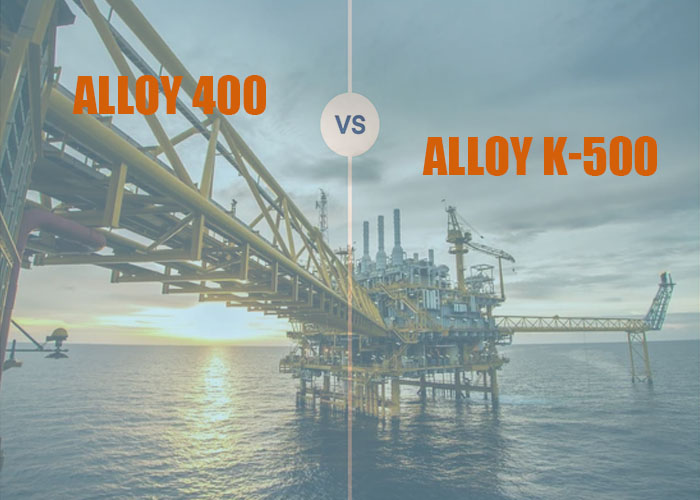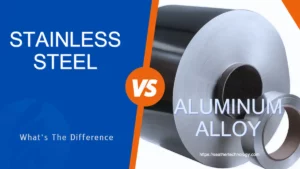The alloy K-500 is non-magnetic and has more strength than the alloy 400; therefore, alloy K-500 is mostly used in heavily loaded applications. While the alloy 400 is magnetic and very ductile.
If you want to choose one of these quality alloys for your project, this informative guide is beneficial for you.
Let’s keep reading.
What is Alloy 400?
Alloy 400 is a nickel-copper alloy, also known as UNS N04400 alloy.
It is a solid-solution alloy that is cold-worked to harden it. It has good properties for corrosive conditions and strong toughness and high strength over a wide range of temperature variations.
The alloy 400 is widely employed in many industries, including processing chemicals and marine materials. Pumps and valves are frequently used.
Several types of alloy with a composition of 63–34% nickel, 34–36% copper, 1.5–2% manganese, and 2.2–2.5% iron. The several versions of
Alloy 400 are valued for their resistance to acid and alkali effects. It has excellent strength and is easily cold-workable to harden.
The 400 alloy is mostly utilized in industries because of its resistance to degradation.
Since the metal is so beneficial, the cost is slightly high for most uses.
Alloy 400 has several unique advantages, including being malleable, stronger than steel, extremely resistant to acids and alkalies, and having good resistance to sulfuric and hydrofluoric acids.
What is Alloy K-500?
Alloy K-500 is an age-hardenable copper-nickel alloy that combines alloy 400’s properties for corrosion resistance with those for erosion resistance and high-strength fatigue.
The precipitation hardening process for alloy K-500 involves the inclusion of titanium and aluminum.
The alloy K-500 has increased hardness and strength while maintaining 400-level corrosion resistance with ease. It demonstrates tensile and yielding strength.
Before the precipitation hardening, it might be strengthened by cold working. The K-500 exhibits good mechanical qualities at sub-zero temperatures up to 480 degrees Celsius.
Due to its exceptional corrosion resistance, it is often employed in chemical and marine conditions. You may observe its extraordinary resistance to non-oxidizing salts, mineral acids, alkalis, and clean water.
Alloy K-500 has several extraordinary benefits, including a pleasing look, good ductility, strong mechanical strength, and great corrosion resistance.
Alloy 400 VS. Alloy K-500 Comparison
To see the comparison between alloy 400 and alloy K-500 we must understand the chemical composition and physical properties of these two alloys.
Chemical Composition of Alloy 400
Nickel: 63%
Iron: 2.5%
Manganese: 2.0%
Silicon: 0.5%
Carbon: 0.3%
Sulfur: 0.024%
Copper: 28-34%
Physical Properties of Alloy 400
Density: 8.80 g/cm³
Melting range: 1300-1350 °C
The alloy 400 is magnetic in nature
Mechanical Properties of Alloy 400
Tensile strength: 517-620MPa
Yield strength: 172-345MPa
Elongation: 48%
Chemical Composition of Alloy K-500
Nickel: 63% Min
Copper: 27-33%
Aluminum: 2.30-3.15%
Iron: 2.0% Max
Manganese: 1.50% Max
Titanium: 0.35-0.85% Max
Carbon: 0.25% Max
Phosphorous: 0.020% Max
Sulfur: 0.010% Max
Silicon: 0.050% Max
Physical Properties of Alloy K-500
Density: 8.44 g/cm³
Melting range: 1315-1350 °C
The alloy K-500 is non-magnetic in nature.
Mechanical Properties of Alloy K-500
Tensile strength: 620MPa Min
Yield strength: 275MPa Min
Elongation: 30% Min
The alloy 400 has a sulfur concentration of less than 0.024%.
Alloy K-500 has a sulfur concentration that is less than 0.01%. It increases the tensile strength and durability of K-500 over 400.
The alloy K-500 and 400 have a maximum manganese percentage of 2.00% and 1.50%, respectively.
This space gives the alloy K-500 enhanced long-term durability.
Therefore, selecting a K-500 alloy with higher creep qualities is advised if your application requires the alloy to be placed under stress for a long time.
What are the Alloy 400 VS Alloy K-500 Applications?
Applications of Alloy 400
Due to its high strength and corrosion resistance, alloy 400 can be used in several products and is effective throughout a broad temperature range. Different grades are employed in various applications, from marine applications to the aerospace industry.
Due to its resistance to both steam and seawater atmospheres, it is often utilized for pipes. Its durability and anti-corrosive qualities make it perfect for demanding applications like oil industry piping.
Applications of Alloy K-500
The alloy K-500 is used to manufacture chains, cables, fasteners, and springs for marine use, pump and valve components for chemical processing, and doctor blades and scrapers for pulp processing in paper production.
Due to outstanding corrosion resistance, alloy K-500 is also used in oil well drill collars and instruments, pump shafts and impellers, non-magnetic housings, safety lifts, valves for oil and gas production, sensors, and other electronic components.
Which one between Alloy 400 VS Alloy K-500 is better?
The alloy 400 is a single-phase alloy that a solid solution has strengthened. In comparison, the alloy K-500 has been strengthened by precipitation due to the addition of titanium and aluminum.
In terms of several strength and hardness indicators, alloy K-500 is superior to alloy 400 due to this important difference.
The K-500 alloy should be prioritized if your product has higher strength and hardness requirements. The overall working performance of alloy K-500 is better than alloy 400.
Conclusion
Both the alloy 400 and alloy K-500 play a vital role in the industry due to their outstanding properties and number of applications.
The alloy 400 is known for toughness and corrosion resistance while the alloy K-500 alloy is known for its strength and excellent corrosion resistance.
After reading this article, you can easily choose one of these alloys according to your desired properties and nature of work.






